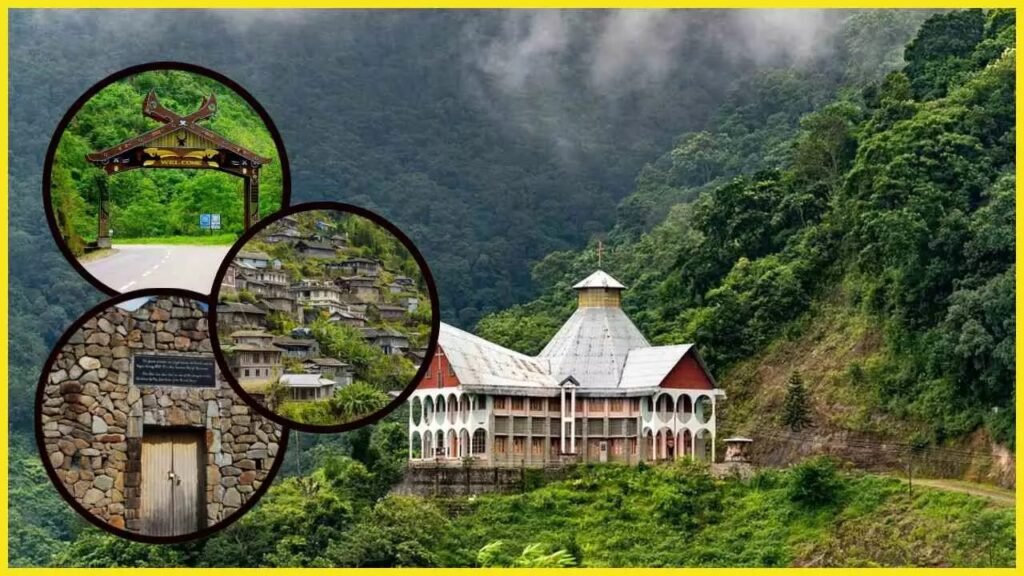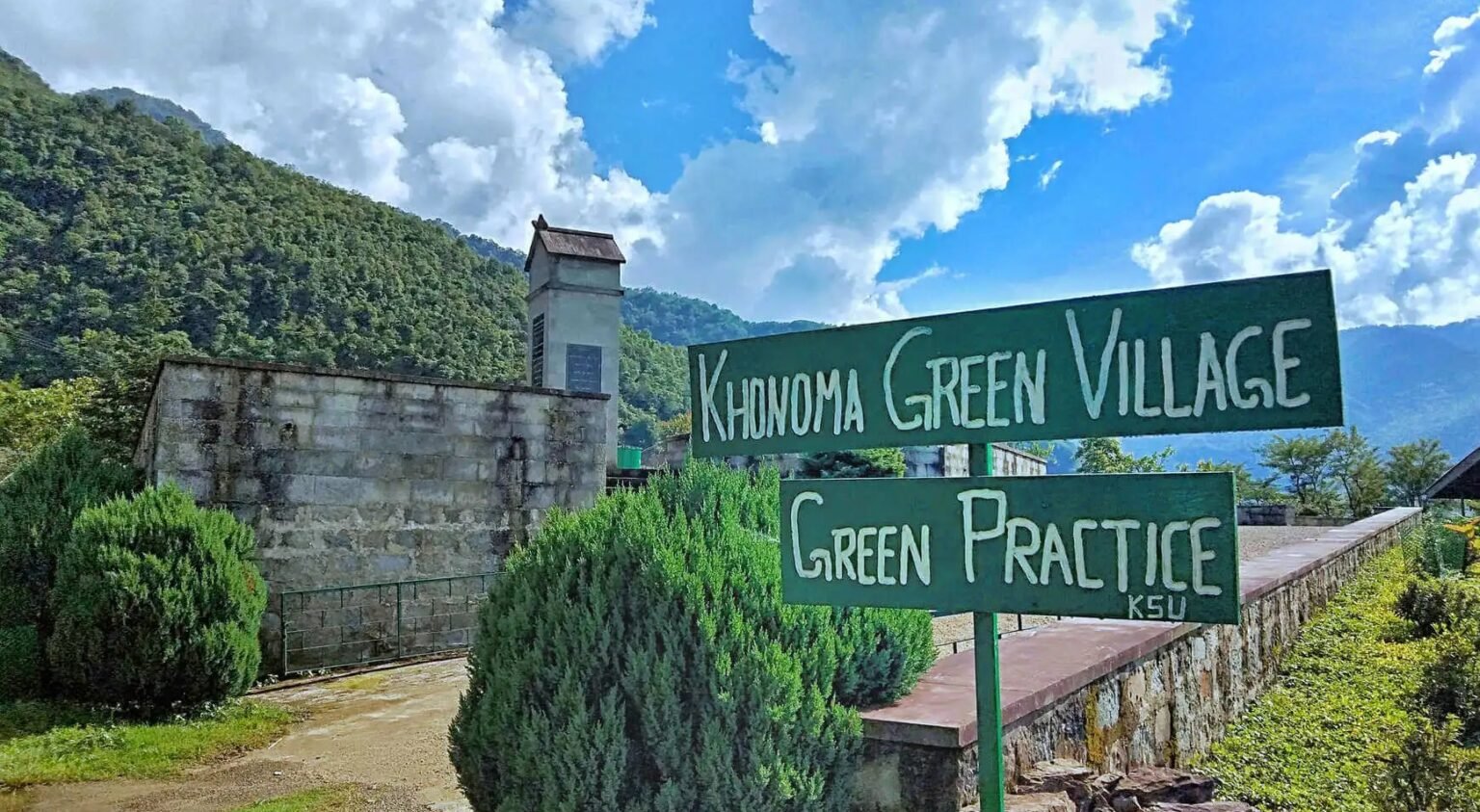Khonoma Village, nestled in the hilly terrains of Nagaland, stands as a model of sustainable living, rich cultural traditions, and storied history, making it a must-visit destination for nature lovers and culture seekers alike.
Location and Accessibility
Khonoma Village is located approximately 20 kilometres west of Kohima, the capital city of Nagaland, in Northeast India. The coordinates are 25.65°N, 94.03°E, in the foothills of the Japfu mountain range. The road journey from Kohima takes about 45 minutes by taxi or private vehicle and passes through scenic landscapes dotted with forests and terraced fields. Travellers arriving via Dimapur railway station or airport can easily reach Kohima and continue to Khonoma by road.
Route Information
- By Road: Taxi or private car from Kohima (20 km, ~45 minutes) is the fastest and most comfortable option.
- By Rail/Air: Reach Dimapur, then road transport to Kohima, followed by transfer to Khonoma.
- On Foot: Trekking is possible for adventure seekers, taking about 4 hours from Kohima.
Key Details:
- The best visiting months are October to April, especially November to February, for pleasant weather and most festivities.
- Cost ranges: The daily budget for travel entry/homestay/food combined per day can be set between ₹2000 and ₹ 6000, or for a full basic trip, ₹10,000, with scaling options according to preferences.
History: The Warrior Village
Its history is dominated by its legacy of fierce resistance against British colonial forces from 1830 to 1880. The Angami Naga warriors, renowned for their combat prowess, waged the ‘Battle of Khonoma’ in 1879, which culminated in the death of several British officers and a siege that lasted for months. Eventually, a peace treaty in 1880 marked the end of organised Naga resistance against the British, etching Khonoma’s name in the annals of Indian independence history.
Embracing Christianity and Transformation
Christianity was introduced to Khonoma in 1890 by the American Baptist Mission, gradually influencing the villagers’ way of life and leading to a harmonious blend of indigenous and Christian practices. This transformation is evident today in the numerous churches scattered throughout the village.
Khonoma: Asia’s First Green Village
In 2005, it was officially declared India’s and Asia’s first Green Village, a distinction earned through its community-driven conservation efforts. A local sanctuary, the Khonoma Nature Conservation and Tragopan Sanctuary (KNCTS), protects over 20 square kilometres. Strict bans on hunting and logging have allowed endangered species, such as Blyth’s tragopan, to flourish once again. Today, Khonoma is widely recognised for its pioneering role in grassroots ecological sustainability, inspiring similar initiatives across India and neighbouring countries.
Culture and Traditions
The people of Khonoma belong primarily to the Angami Naga tribe, boasting a heritage that spans over 700 years. Central to their lifestyle are the ‘morungs’, traditional dormitories and cultural centres where young villagers learn the skills of martial arts, woodworking, farming, and local customs. Gender roles are deeply respected; certain taboos, such as prohibiting women from touching ritual spears and men from using women’s weaving machines, preserve the sanctity of age-old practices. Community festivals, crafts (such as basketry and weaving), and collective farming create a vibrant, close-knit society.
Economy and Tourism Revenue
Once reliant on hunting and subsistence agriculture, Khonoma’s economy now thrives on tourism, especially eco-tourism, homestays, the sale of handicrafts, organic produce, and guided tours. The first homestay opened in 2006, and currently, dozens of households provide authentic stays to over 4,000 visitors annually. Women-led plant nurseries, handicraft workshops, and guiding services diversify incomes, funding education and healthcare. However, while Khonoma attracts the highest tourist footfall among Nagaland’s villages, its overall revenue generation is still behind that of villages like Tuophema. This is driving initiatives to improve tourist facilities and increase visit durations.
Unique Social Values: The Honest Village
Khonoma is known nationally as India’s most honest village, with a nearly crime-free record. Shops and homes are left unlocked, and residents maintain a culture of trust and communal responsibility. This ethical foundation contributes to the harmony that pervades daily life.
List of Major Tourist Spots
Here are the must-visit places in Khonoma Village:
Agriculture, Environment, and Sustainable Living
Its terraced fields and ‘jhum’ cultivation, a form of rotational farming that incorporates Himalayan alder trees, showcase centuries-old sustainable agricultural knowledge. The community’s environmental leadership earned it India’s National Biodiversity Award (2021) and global recognition as a UNWTO Tourism Village. Forest land and gardens yield rice, millet, corn, vegetables, and unique products, such as candied wild apples.

Festivals and Events
The Thekranyi Festival, celebrated annually in Khonoma, marks the end of the old year and the beginning of the new with music, feasting, and traditional rituals. Local festivals throughout the year attract tourists eager to experience Angami hospitality and witness cultural performances.
Revenue and Community Benefits
Tourist entry fees, homestays, handicraft sales, and the gathering of local produce all contribute to the village’s income. Proceeds are invested in education, health, and infrastructure, with continued support from government and non-profit partners.
FAQs About Khonoma Village
What is Khonoma Village famous for?
It is renowned for its rich history as a warrior village, its status as the first Green Village in Asia, its thriving eco-tourism industry, and its honest society, where theft is virtually unknown.
How can visitors reach Khonoma Village?
Visitors can take a taxi or hire a private vehicle from Kohima (approximately 20 km away) or use public transportation from Dimapur to reach Kohima. Trekking is also possible for adventurers.
What are the main attractions of Khonoma?
Major attractions include Khonoma War Memorial, Morung cultural centres, Khonoma Nature Conservation Sanctuary, Mount Japfu, family tombs, and handicraft workshops.
What makes Khonoma’s community unique?
It is lauded for its honesty, communal trust, strict ethical norms, and sustainable living practices, including a crime-free environment and unlocked shops.
What is the economic impact of eco-tourism in Khonoma?
Eco-tourism, homestays, handicraft sales, and guiding services provide diversified income to villagers, driving community development in education and health.
When is the best time to visit Khonoma?
The optimal time to visit is from October to April, when the weather is pleasant and local festivals are held.
What role does Khonoma play in conservation?
It pioneered community-led conservation by creating the Khonoma Nature Conservation Sanctuary, which protects 20 sq. km and endangered species, and teaches other villages sustainable practices.
Is English spoken in Khonoma?
While villagers primarily speak Angami, many locals, especially those in the tourism industry, understand and speak English, making communication easier for travellers.
